Remembering the EDSA Uprising
Remembering the EDSA Uprising
The massive upheavals and the People Power Revolution that toppled the former President Ferdinand Marcos were commemorated on Feb. 24, 2012 at the event, “The Philippines: EDSA 1986 Memories of a People Rising.”
Hundreds of thousands of people filled the EDSA highway in Manila in February 1986 after years of popular uprisings against the violent and authoritarian Marcos regime came to a tee. The assassination of Ninoy Aquino in 1983 and the fraudulent election of 1986 spurned defections of high ranking military officials, politicians, and clergy against Marcos. Meanwhile on the streets, a huge mass of non-violent protesters gathered to oust the decades-long dictatorship.
“We need to tell our children why we chant, ‘Tama na! Sobra na! Palitan na!’ (We’ve had enough! Things have gone too far! It’s time for a change!),” said one of the evening’s emcees, the Secretary General of Migrante Canada, Chris Sorio. The event was organized by Community Alliance for Social Justice (CASJ), Bayan Canada, and Migrante Canada.
This is why twenty-two year old, Jesson Reyes, who came to Canada when he was 10 years old, said he attended the event. He came as part of his ongoing personal learning of Philippine history as it relates to the situation now.
Lapulapu Caña who was here when EDSA happened said, “You could not escape the news (of EDSA) even if you were in Canada.”
“I think every Filipino has to place importance and remember this event because it proves that we are a freedom loving people and we will fight for freedom at all costs. People Power put the Philippines on the map.”
More chairs had to be brought out as the Fireside Room in Trinity-St.Paul’s United Church on Bloor Street West became filled as more than two dozen people gathered to hear the stories of EDSA from political activists, church people, former political prisoners, diplomats, and overseas Filipinos.
Even before Martial Law, there were protests in the 1960s and 1970s , during the First Quarter Storm and the years following. The first trade union strike of a liquor-making company, La Tondeña, in 1975 defied Martial Law, shocked the nation, and proved it could be done, as did the Ford Motors strike that followed. This was combined with the mass organizing on the farms and in universities.
Corpuz led and organized student protests as the vice-president, then president of the student council at the University of the East. The university population was the largest in the Philippines, and it was located a few blocks to Malacañang, the official residence and principal workplace of the Philippine president. At times, 50,000 people would come out to the protests right beside the home of Marcos with cries to expose his dictatorship.
The students also helped organize the Lakbayan caravans– jeepneys full of rural farmers, some coming to Manila for the first time, to protest against the Marcos regime.
As a result, Corpuz and other students were branded as “progressive subversives” and were blacklisted by school authorities. He was not allowed to his graduation ceremony, even though he did graduate.
Ricky Esguerra said people should look at EDSA as a culmination of the people’s struggle against the dictatorship. Those who have always been oppressed, such as peasants and workers, have always acted for change. However, during EDSA, the professional and middle class, such as doctors and the clergy, all came out to mobilize for change and managed to topple the Marcos regime.
Editor-in-chief of The Philippine Reporter and CASJ President, Hermie Garcia, shared with the audience his heart-breaking experiences during Martial Law as a political detainee in Camp Crame and Bicutan. He and the other detainees were subjected to physical and mental torture and isolation. He described the torture his friend, journalist and writer Pete Lacaba, endured until he vomited blood. The torture was nicknamed the San Juanico Bridge and involved the head and shoulders of the prisoner being put on a bed, while the legs were put on another bed. Then guards would punch the prisoner’s stomach.
Garcia told the tragic story of how his brother was tortured. His brother was in a car with his parents, passing through Camp Crame, and was stopped. When they identified themselves, the guards recognized the name, because Garcia and his brothers all have the same name (Hermie the second, third, fourth and fifth). They brought his brother to Fort Bonafacio. With his parents in the next room, Garcia said they “tortured him overnight until the next morning while my parents could hear what they were doing to him.”
His brother had no political involvement prior to be being arrested, but after his arrest, and detainment for two years, he became politicized. Garcia’s brother escaped prison, joined the underground and was with a labour group when he was arrested again. As tears welled in his eyes, Garcia told the audience, a few years later while he was still in detention, he heard that his brother was executed.
Groups worked tirelessly to free the political prisoners, such as Kapatid, the organization Connie Sorio of the NGO, KAIROS, told the audience about. They used all available media and spoke at protests to bring awareness to the existence and plight of the prisoners, who could easily be killed or disappeared without a trace.
The release of the political prisoners was not immediate after EDSA. It was only because of the persistent calls of the family and friends of the political prisoners did Marcos’s successor, former President Cory Aquino, fulfill her campaign promise to release the political prisoners.
Mila Astorga-Garcia told the audience about her experiences as a female journalist in the Women Writers and Media Now organization during and after Martial Law. The media was one of the many sectors fighting against the Marcos regime. Astorga-Garcia said, “the women writers stood prominently as fighting writers. So much so that one male writer said, ‘The women writers were the ones who had the balls.’” Many of the women were being harassed and intimidated and were often asked to apologize for anti-Marcos or anti-military articles.
The event included clips from the movie, Batas Militar (Military Law) a comprehensive and progressive movie about EDSA. Songs by Louie Queano and Jay Carpio opened and closed the night’s events.
The last speaker of the evening was the Toronto Consul General, Pedro Chan. During EDSA, he was the acting Consul General in Los Angeles, California. At the time, he led the defection of Filipino diplomats around the world against the Marcos regime, joining the people’s protests at EDSA.
However, Chan began his address to the audience by saying, “I am not an EDSA hero, if at all, just an accidental hero.”
“To me the real heroes are those former classmates and friends of mine back in Samar who went to the hills, and joined the underground movement. They lost their lips, their sanity, their future, died or were murdered or had fallen while fighting the entrenched dictatorship as they pursued against insurmountable odds the protracted class struggle to truly liberate our people and our land.”
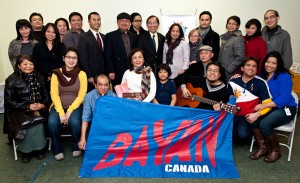
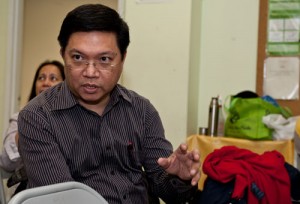
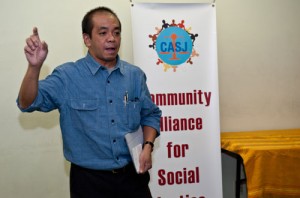
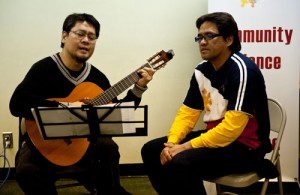

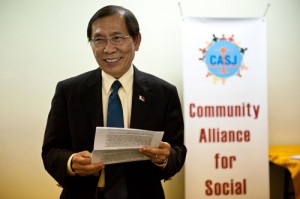
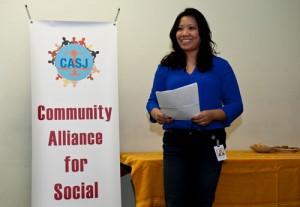
Comments (0)